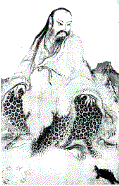
Fu Hsi (about 4,000 BC) is the father of the Chinese Tai Chi Philosophy of yin and yang and thus the I Ching. He is the first in recorded history to have invented a theory of everything (physicists have the superstring theory). To him everything was a combination of trigrams ( like yin-yang-yin or yang-yin-yin). There are eight trigrams, which are also phases in a universal cycle. For the first time, he symbolized yin as a broken line, yang as an unbroken line. These were observed to appear as vacated turtle shells cooked in a fire. Their appearance (It usually took three shells to get a reading) indicated the phase in the focus of attention. By the law of synchronicity, appearing symbols relate to the appearing world. Read a fascinating (partially fictional) biographical sketch of Fu Hsi in A Tale Of The I Ching by Wu Wei, Power Press, P.O. Box 66401, Los Angeles CA 90066.